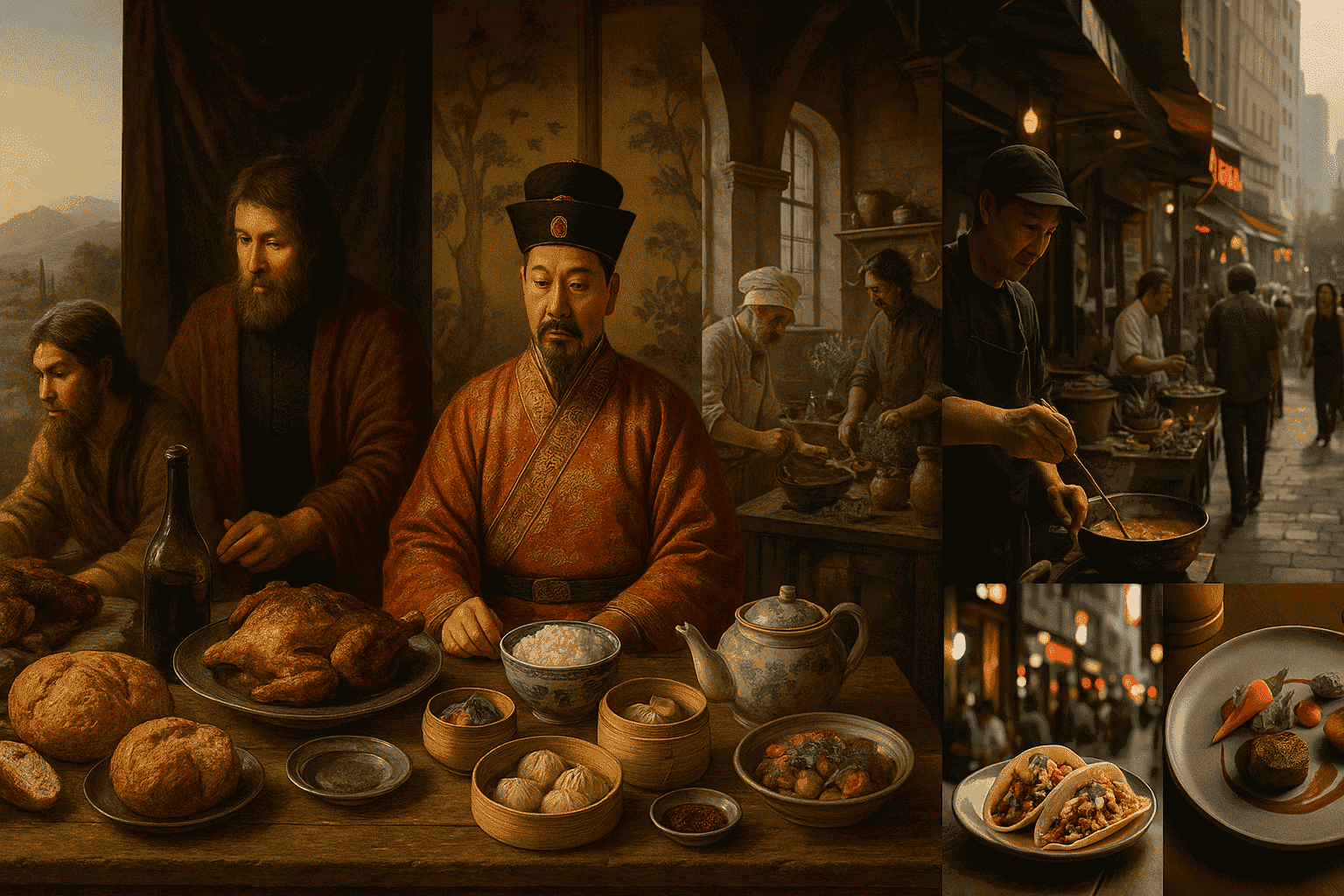The History of Food and Cuisine Around the World: A Journey Through Taste and Time

Introduction
Food is far more than nourishment — it’s culture, history, identity, and storytelling on a plate. Every bite we take carries echoes of centuries-old traditions, migrations, trade routes, conquests, and innovations. The history of food and cuisine is, in many ways, the history of humanity itself. This journey through taste and time explores how different regions shaped their food traditions and how these flavors evolved into the rich global cuisine we enjoy today.
1. Beginnings — From Foraging to Farming
Our culinary journey begins in prehistory. Early humans were hunter-gatherers, relying on whatever nature offered — wild fruits, roots, grains, nuts, and meat. Cooking emerged as a revolutionary step, allowing food to be safer, tastier, and more digestible.
The Agricultural Revolution (~10,000 BCE) marked a turning point. Humans began cultivating wheat, barley, rice, and maize. Farming not only provided stability but also laid the foundation for permanent settlements. This gave birth to regional cuisines based on available crops:
- Middle East: Wheat and barley, leading to bread-making traditions.
- Asia: Rice cultivation shaping cuisines of China, Japan, and India.
- Americas: Corn, beans, and squash — the “Three Sisters” — forming the backbone of indigenous diets.
2. Ancient Civilizations and Culinary Innovation
Food in ancient civilizations was a blend of sustenance, symbolism, and art.
- Egypt: Bread and beer were staples, accompanied by vegetables, dates, and fish. Pharaohs enjoyed lavish feasts with honey, figs, and exotic spices.
- China: By 2000 BCE, rice and soy were central. Chinese cuisine began developing the sophisticated balance of flavors — sweet, sour, salty, bitter, and umami.
- Greece: The Mediterranean diet began here, emphasizing olive oil, wine, bread, and seafood. Food was tied to philosophy, festivals, and religion.
- Rome: Roman cuisine borrowed from Greece and expanded through its empire, introducing imported spices, wine, and new cooking methods.
3. The Medieval Era — Spice, Trade, and Cultural Exchange
The medieval period was defined by trade routes and the spread of spices. From the Silk Road to the spice routes of the Indian Ocean, exotic flavors traveled far beyond their origins.
- Europe: Medieval feasts showcased spices like cinnamon, cloves, and pepper — luxury items symbolizing wealth.
- Middle East: The Arab world became a culinary hub, blending Persian, Turkish, and North African flavors. Dishes like pilaf and baklava have roots here.
- Asia: India flourished as the source of spices. China perfected tea culture, and Japan refined sushi and noodle traditions.
4. The Age of Exploration — Culinary Globalization
The 15th–17th centuries brought unprecedented food exchange. Explorers and traders brought foods across continents, forever transforming diets.
- Columbian Exchange: Potatoes, tomatoes, maize, chili peppers, and cacao traveled from the Americas to Europe, Africa, and Asia. Wheat, coffee, and sugarcane traveled in the opposite direction.
- Africa: Introduced to new staples like cassava and peanuts, which became central to many African cuisines.
- Europe: Tomatoes and potatoes revolutionized Italian and Irish cooking, respectively.
- Asia: Chili peppers transformed Indian, Thai, and Chinese cuisines.
5. Modern Era — Fusion and Global Cuisine
Industrialization, migration, and globalization have turned the world’s kitchens into melting pots of flavors.
- Colonial influence: European empires introduced culinary fusion — Indian curry adapted for British tastes, or Caribbean dishes influenced by African, European, and Asian flavors.
- Immigration: Italian pasta, Chinese stir-fries, and Middle Eastern kebabs became staples worldwide.
- Modern trends: Farm-to-table, molecular gastronomy, plant-based diets, and fusion cuisine illustrate the dynamic evolution of food today.
6. The Future of Food
As climate change, population growth, and technology reshape our world, the future of cuisine will likely include:
- Sustainable agriculture and lab-grown meats.
- Increased use of alternative proteins (e.g., insects, algae).
- Continued blending of traditions through cultural exchange.
- Food as a statement of identity and sustainability.
7. Food as a Cultural Bridge
Food connects us in ways few things can. Across continents and centuries, cuisine has been a record of human innovation, migration, and cultural exchange. A single dish can carry the history of empires, trade routes, and cultural fusion. Whether it’s a steaming bowl of ramen in Tokyo, spicy tagine in Marrakech, or a slice of pizza in Naples, each bite tells a story — a story worth savoring.
Conclusion
The history of food is a history of people, places, and possibilities. It reflects who we are and where we come from, and it shapes who we might become. From the first fires that cooked our ancestors’ meals to the latest culinary innovations, the journey of cuisine is far from over. The world’s kitchens remain alive with history — a living, breathing journey through taste and time.